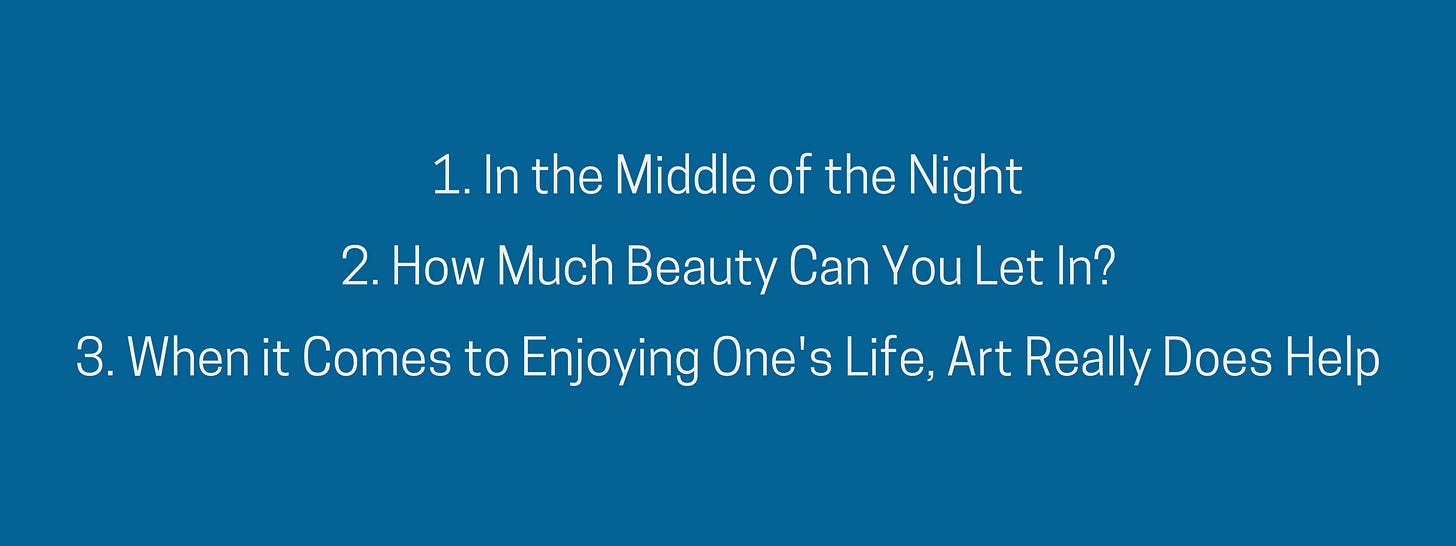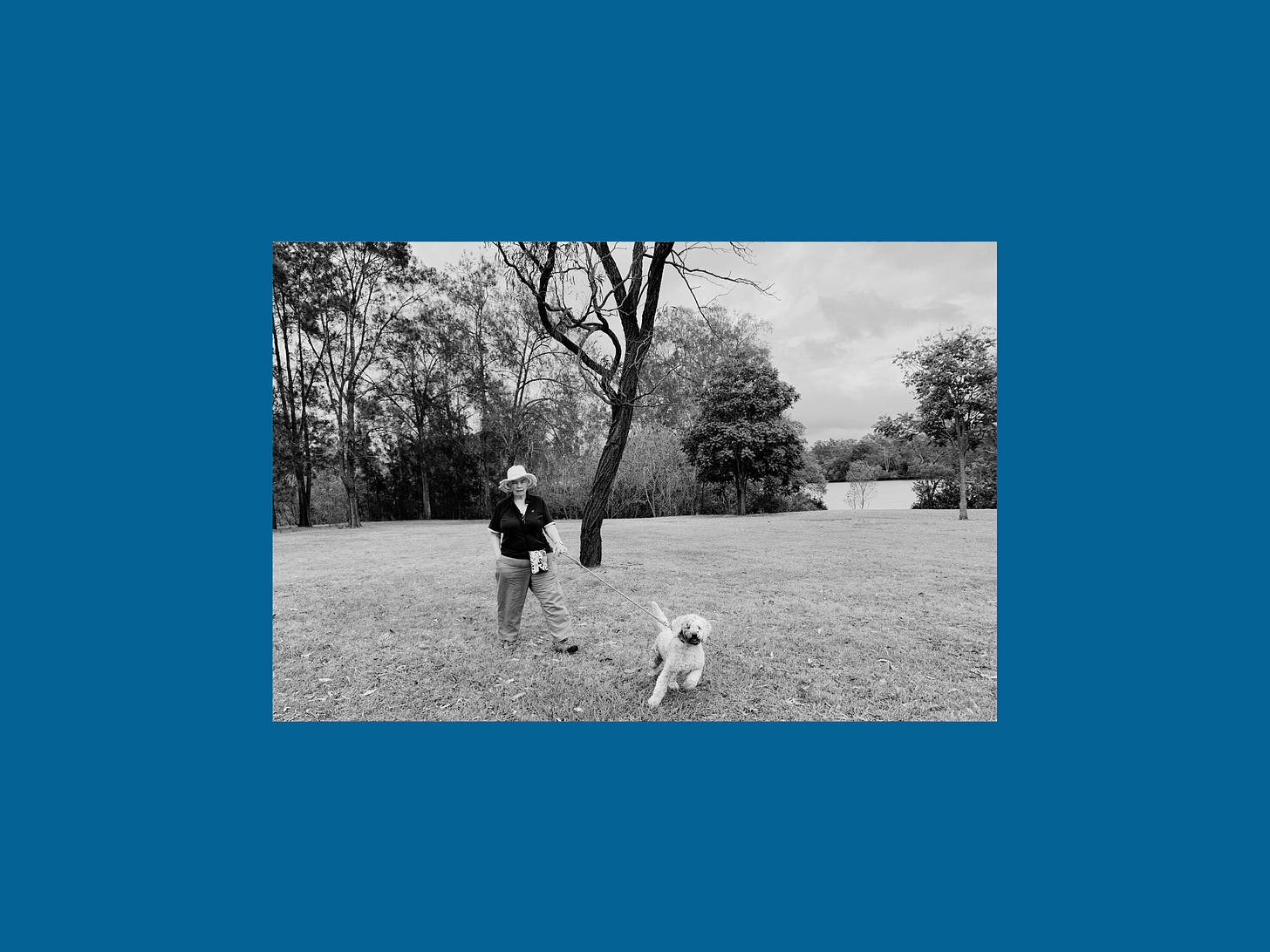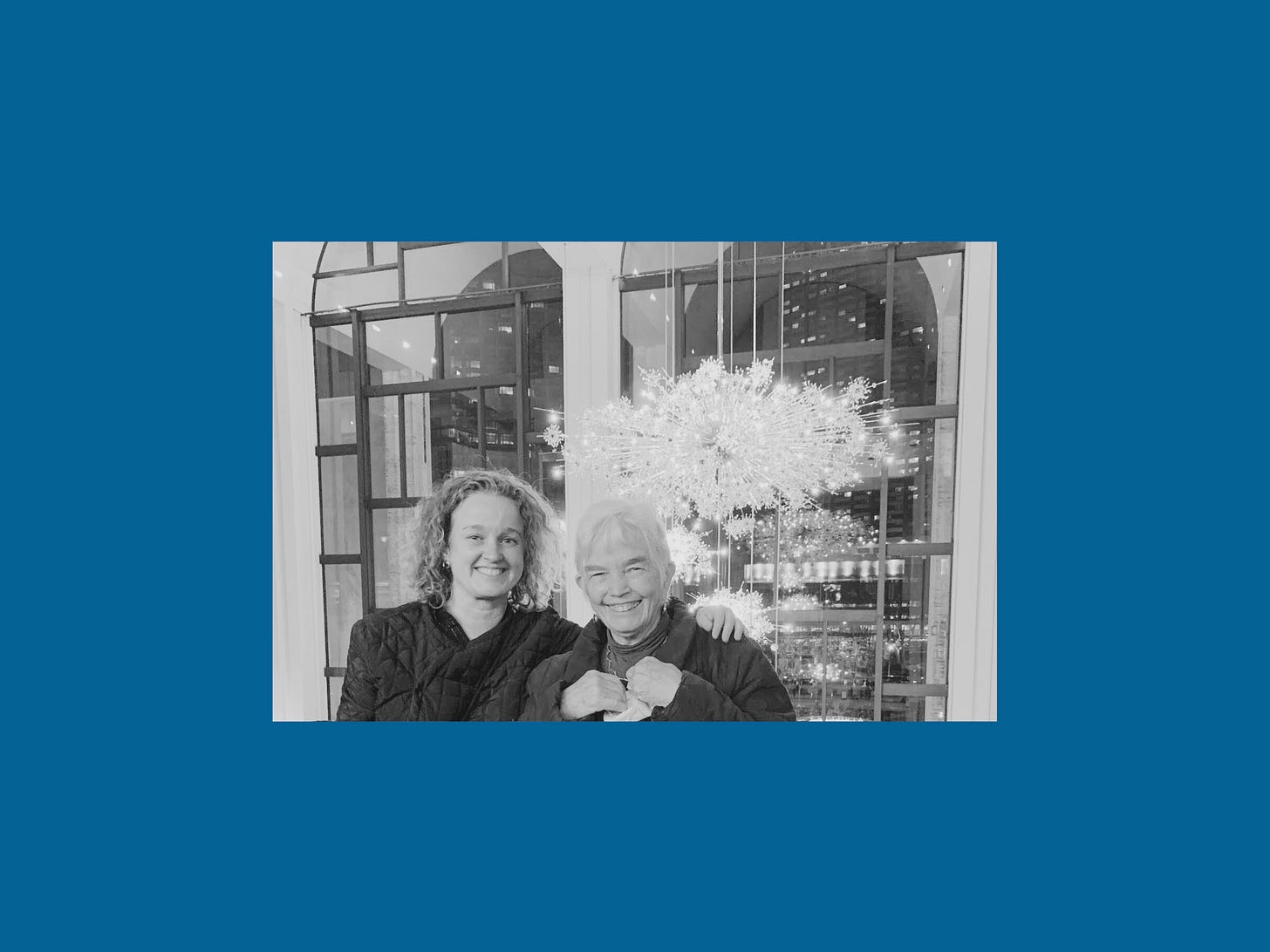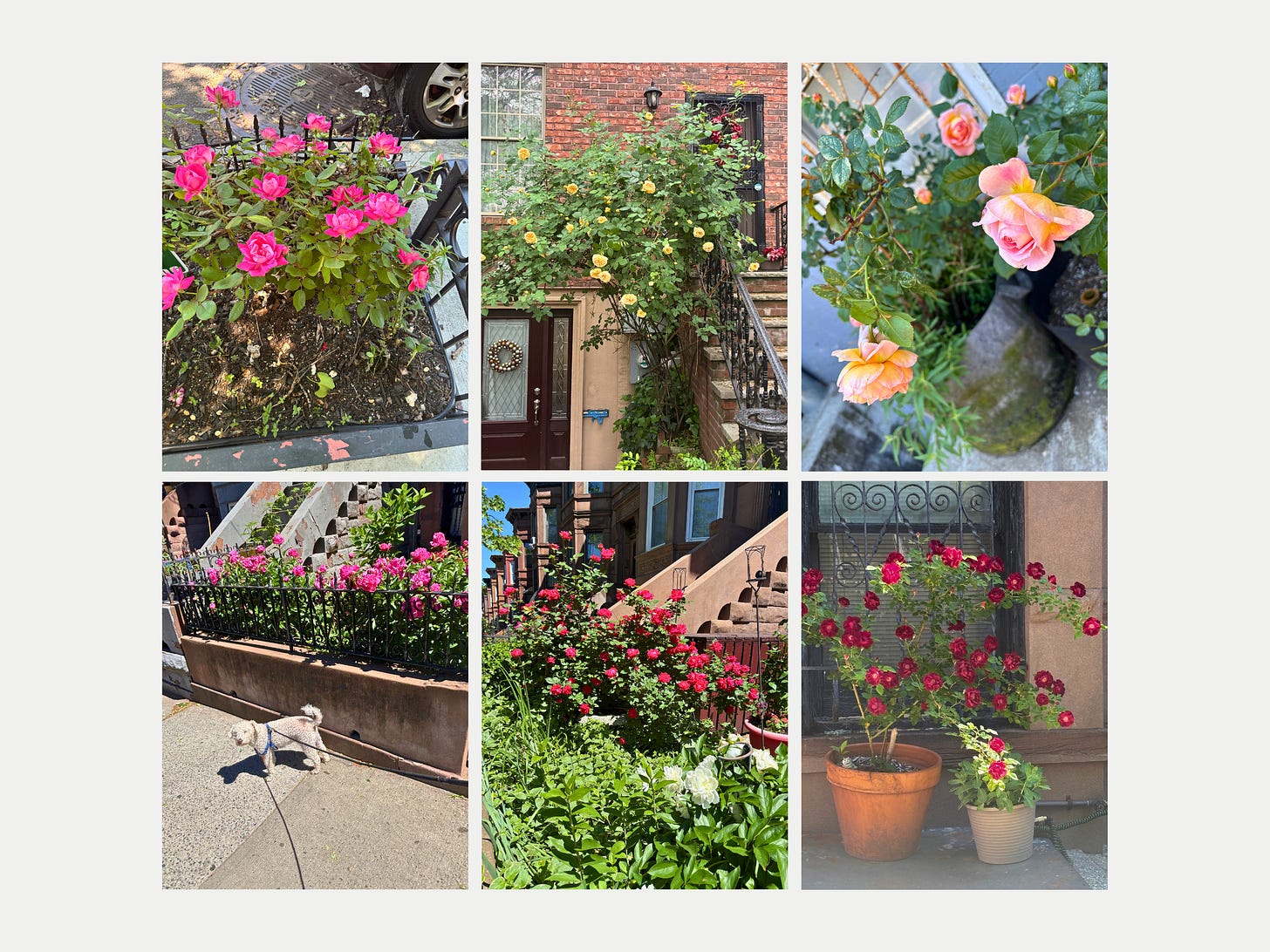There are two streams to my newsletter: (1) Objects of Civility (OoC)—insights on building thriving cultures (at work and beyond), even in divisive times. (2) Creative Civility—personal essays on being human, especially in divisive times. Today's is the latter, the personal.
1.In the Middle of the Night
Mum video-called me at 2am her time. It was around noon for me, and as I answered I was a bit apprehensive. She's had a string of health issues this past year, most recently debilitating pain in her left hand. This sounds like a moderate thing, but it means she can't always get dressed or drive her car or manage the dog's lead and go on her long walks without help. Experiencing searing pain—and the loss of the everyday joys and dignities that require two hands—has, as she said, "really lowered my spirits."
But as her face filled the screen, she was beaming. "Guess what!" she said. "I just woke up and realized I felt good enough to take a shower. AND I was able to put my bra on!" She lifted up her top and flashed her bra at me, shrieking with joy.
She was lying in bed freshly showered and ready to go back to sleep, but had one of her going-out tops on so that no matter how she felt in the morning, she'd be dressed and ready for her doctor's appointment. (This is a fine example of being unstoppable, point 4 on last week’s newsletter.)
"I have good news too!" I laughed. "I went and saw an incredible play last night—The Picture of Dorian Gray—and the whole experience was mesmerizing and psychotic and beautiful. I'm kind of elated. I can't believe I got to experience such an extraordinary piece of art."
"Oh exactly!" she replied. "Art and nature is so good for our mental health. Sally (her niece who lives across town) came and tied my shoes for me yesterday, and then she took me to a talk at the art gallery, and then we had lunch with a group there and it was wonderful. It really lifted our spirits. It's probably why I woke up at 2am ready to have a shower!"
We laughed.
Enjoying one's own life really takes something. It takes celebrating the moments when you feel up to taking a shower, even if it's in the middle of the night. And it takes counting your lucky stars when you live the kind of life where, every now and again, you get to see something as extraordinary as Sarah Snook preforming The Picture of Dorian Gray on Broadway.
2.How Much Beauty Can You Let In?
I agree with Mum—art is good for our mental health. But I've also found it to be a good litmus test for how our mental health is doing in the first place.
You know how people on podcasts talk about Warren Buffett's compounding wealth that eventually went exponential when he turned 60, jumping from millions to billions? That's what it felt like for me in my last two years leading my old nonprofit. Not with my personal wealth (lol, obviously), but with my personal stress. My stress, which had been compounding over the years, went exponential in the final two.
My mind was almost always whirring with the work of running an organization. My emotional life was consumed with the labor of metabolizing a complex web of human dynamics. All of it driven by a fierce commitment to young people in NYC. But there was little room left inside me to let beauty in.
On the rare occasions I was at the theatre, I was physically present but my mind was far away busy working on an organizational problem. Music? I couldn't hear it above the noise of my thinking. Visual art? Rather than lift me up as it once had, in requiring my attention it seemed to deplete me. For years, I stopped going to see things.
Then a week after my last day as leader, I woke up in Barbados. My calendar, which had often been booked six to twelve months in advance, was empty. That afternoon I sat on the veranda of a local bar looking across a beautiful expanse of blue sea to the horizon, appreciating the cool breeze.
Then I realized my body was swaying. It was moving to the music.
I was hearing music.
This isn't unique to me. Just replace the way I'm using the word "art" with the phrase "work-life balance" and you'll notice this is a common predicament among leaders—or anyone trying to accomplish something larger than themselves. You know, teachers, direct service workers, parents.
On the whole this is an incredibly meaningful and rewarding way to live life.
As long as your stress doesn’t go exponential.
Every now and then, take stock. Ask:
How much beauty can I let in?
This is probably proportionate to how happy you can be in this moment.
3.When it Comes to Enjoying One's Life, Art Really Does Help
Having lived in NYC for 17-plus years, I have finally discovered Broadway. Not the skewed avenue that disorients the otherwise methodical carpet of street grids, which I have long appreciated. But Broadway. The theater district, the music, the art. This has brought some exhilarating moments into my life, and renewed awe (see #3 below) for my fellow humans and the magnificent things they can make possible (at a time when I've been seriously disappointed by most of our collective choices).
In life, most of my time is spent plodding along, making small amounts of progress here and there. Having my everyday occasionally punctuated by the soaring experiences art can offer has made me realize I'm in a quietly happy period of life.
Unsurprisingly then, when I brainstormed all the ways that art is good for our mental health (at all the different scales of civility), it easily exceeded two dozen. But when it came to writing them out, it felt like I was doing sit-ups—it required so much sustained brain-effort to parse out these obvious truths. So I wrote out three and, like I so often do at the gym, declared it to be "good enough."
Art can be restorative. So many of us occupy the world from the neck up, which is to say we understand our experiences intellectually but evade understanding things on a physical or emotional (or other mysterious) level. I explore this a bit in the newsletter Knowing. Art, on the other hand, can leap over our logic and language to reach us through our hearts. Art moves us. It allows us to release emotions—what the Ancient Greeks called catharsis. And so art can free us from our glitch-heavy thinking. We can make sense of things from an entirely new realm and let things go, finding peace, even if just momentarily.
Art can give us agency over our own story. When we practice art, we can actively rewrite our own narratives rather than unconsciously inheriting our stories from the culture around us. But we don't do this just for ourselves—rewriting one's story is a genuine contribution to everyone. As Chimamanda Ngozi Adichie argues in her famous TED talk, we need more than a single story—we need multiple, complex narratives to see the full humanity in ourselves and others. Art creates space for these richer stories to emerge. When I led an arts-based Alternative-to-Incarceration program, we employed this liberally. Instead of being defined by arrest records, young people created "aspirational self-portraits" to represent themselves in court—art-advocacy that shifted not only their self-perception but how judges and prosecutors saw them.
Art can fill us with awe. Psychologist Dacher Keltner explains that awe "helps reduce stress, anxiety, and inflammation in your body while improving cardiovascular function.” Isn't that amazing? And probably why Mum said art and nature are so good for our mental health—nature being another source of awe. But my favorite thing about awe is that in its presence, we become insignificant. And so our anxieties become insignificant too. In this way art takes us out of ourselves and returns us to our oneness with the world around us.
4.In Other News
The roses are blooming in Brooklyn.








